Science & Technology
Top Ten Advances in Science and Technology of Chinese Academy of Geological Sciences in 2011
On January 5 and 6, 2012, Annual Scientific Achievement Exchange and Ten Scientific Advances Selection and Appraisal Meeting 2011 were held in Beijing by Chinese Academy of Geological Sciences (CAGS). This has been the 8th overall review of scientific research achievements since 2004. Twenty-nine outstanding scientific and technological achievements out of 1014 programs of CAGS affiliates were presented at the meeting. The judging panel is composed of 15 academicians and 39 experts from the Ministry of Science and Technology, the Ministry of Land and Resources, the Ministry of Education, Chinese Academy of Sciences, National Natural Science Foundation, China Earthquake Administration, and Sinopec Group, etc. Ten advances in science and technology came out after careful and rigorous review and vote.
1. The first time-domain fixed wing aviation electromagnetic exploration system of independent research and development
Sponsored by National High Technology Research and Development Program of China (863 Program), the team led by Researcher Hu Ping and Li Wenjie from the Institute of Geophysical and Geochemical Exploration developed time-domain fixed wing airborne electromagnetic (AEM) big depth exploration system based on domestic Y12IV airplane. The system has proprietary intellectual property. The team addressed technical problem of big magnetic moment emission by developing 500,000Am2 big magnetic moment transmitter, whose maximum electricity can reach peak current electricity and whose peak magnetic moment is superior to design index. The team made induction coil sensor free from vibration under air disturbance and addressed key techniques of pneumatic disturbance avoidance in bird receiving by developing triaxial stabilized vibration-free system, light-weight geometrical-symmetry three-component orthogonal induction coil sensor and receiver. The team achieved mass data real-time collection and storage by developing waveform data acquisition system, which realizes high resolution real-time data collection with data collection and storage speed of over 4.0GB/hr. The prototype with developed system passed semi aviation pilot test and its overall performance reaches international advanced level. The system has 6 national invention patents under application and 3 registered software copyrights.
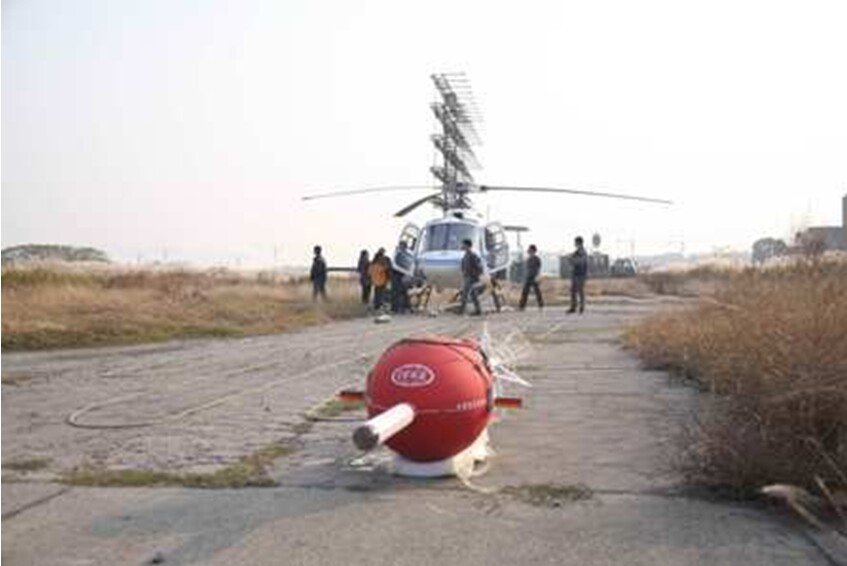
Prototype test
2. Determination of transforming time nodes of Late Mesozoic compressional structure to extensional structure in South China
Sponsored by the program (SinoProbe-08-01), Researcher Dong Shuwen of Chinese Academy of Geological Sciences and Researcher Zhang Yueqiao of the Institute of Geomechanics systematically analyzed fault-slide vector of Devonian-Middle Triassic marine formation, and restored tectonic events and deformation of Triassic collisional orogeny and Late Jurassic-Early Cretaceous intracontinental orogeny. It is for the first time that the team analyzed 5 stages of stress status and transformation of Yuanma Basin, Xuefeng Mountain area since Jurassic and conducted an in-depth research on structure and kinematics characteristics of detachment fault to the west of Hengshan metamorphic core complex, obtaining that the U-Pb age of zircon in detachment fault is 137Ma. By doing so, the team determined transforming age of Late Mesozoic compressional structure to extensional structure in South China and defined bottom age of Cretaceous red formation basin. The team defined two stages of tectono-magmatic events of Changle-Nanao tectonic zone along the southeastern coast, including orogenic shortening period (145-135Ma) and extensional period (132-115Ma), which provides important basis for shortening and extension evolution of Mesozoic orogeny at continental margin of South China continent.

Late Jurassic-Early Cretaceous compressional structure of Yuanma Basin, Xuefeng Mountain area
3. A breakthrough made in marine potash prospecting
Jointly sponsored by geological survey program and National Natural Science Foundation-Yunnan United Fund, research team led by Academician Zheng Mianping compared and analyzed potash-forming regularity at home and abroad, conducted systematic research on geological structures at different ages and potash prospecting direction in China. The team defined 3 salt mineralization area and 1 mineralization belt and put forward national potash prospecting strategy: marine evaporite basin as main objective followed by continental salt lake and potash-bearing underground brine. The integrated execute plan of oil and potash prospecting compiled by the team guides potash prospecting effectively. The team discovered thick layers of potash mineralization in Ordovician salt basin in northern Shaanxi and defined potash prospecting direction. The team clarified Palaeogene salt layer thickness and distribution in Kuqa Depression, Tarim Basin, discovering thick layers of potash in deep halite debris, and conducted systematic survey of giant potassium-lithium-boron prospect of salt lake in Tibet, discovering Dogai Coring large potassium-lithium-boron rich salt lake. The team put forward that potash layers in southwestern Yunan Province origin from deep Mesozoic salt-bearing rock series, which is being verified by drilling around Well Mengye. All relevant research is of great significance for national potash prospecting.

Academician Zheng Mianping is investigating in Well Mengye, Yunan.
4. Obtaining new data about karst carbon sink in carbon absorption and release balance
Sponsored by geological survey program, the team led by Researcher Jiang Zhongcheng of the Institute of Karst Geology conducted research on national karst carbon sink and made progress. In order to conduct research on carbon sink in typical karst catchments, the team built observation station network and discovered that allogenic water contributes a lot to karst carbon sink in karst catchments. The team worked with international organizations to conduct quantitative research on carbon sink generated by photosynthesis of aquatic organism. The team demonstrated stability of karst carbon sink, discovered manual intervention approach to increase karst carbon sink, and deepened understanding about process and mechanism of karst carbon sink. The team classified karst areas in China into southern karst area, northern karst area, Qinghai-Tibet Plateau karst area, and buried karst area, calculated and analyzed karst acreage and karst carbon sink volume with GIS technique for each area. The team estimated that national annual karst carbon sink volume reaches 36990 thousand tons of CO2. This provides data and basis for international negotiation on emission reduction, dealing global climate change, making an energy conservation and emission reduction plan. International known journal Science presents achievements of karst carbon sink research program and speaks highly of them.
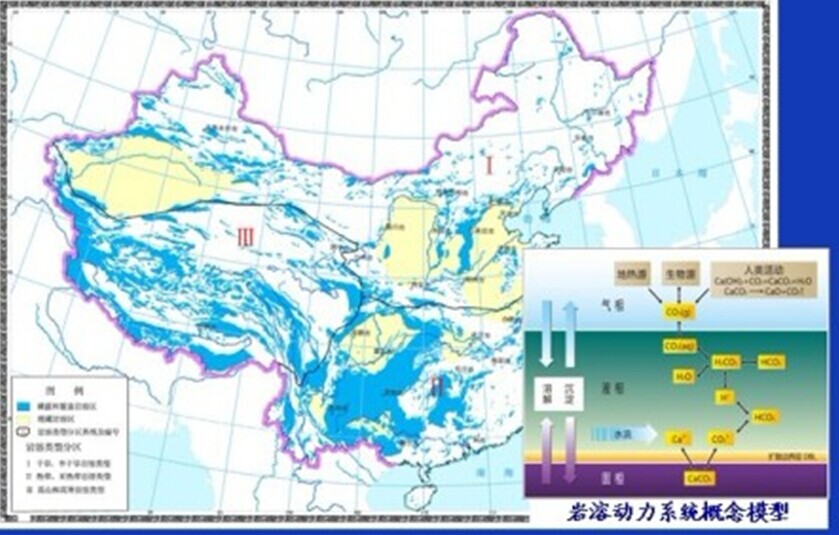
National karst areas and acreage calculation
5. In situ light isotope analysis technique in quantitative research on paleoclimate environment change
Sponsored by the Ministry of Science and Technology, Researcher Liu Dunyi introduced and applied SHRIMP Ⅱe-MC oxygen isotope micro in situ analysis technique for in situ micro light isotope analysis of microfossil formed during deposition. The team selected over 200 conodont fossils from 49 horizons around Permian/Triassic boundary of Wenbudangsang Section for in situ oxygen isotope test analysis and high accuracy measurement of oxygen isotope. It is found that oxygen isotope ratio of conodont decreases sharply from 20.9‰ to 19.03‰ over the Permian/Triassic boundary, which corresponds to global warming at the end of Permian and indicates dramatic change of surface temperature of paleo-sea. Surface temperature of Tethys paleo-sea in middle and high latitudes increased about 8.2℃, which helps understand causes of the biggest group extinction of Phanerozoic. Relevant research provides guide for quantitative analysis of paleoclimate environment change.
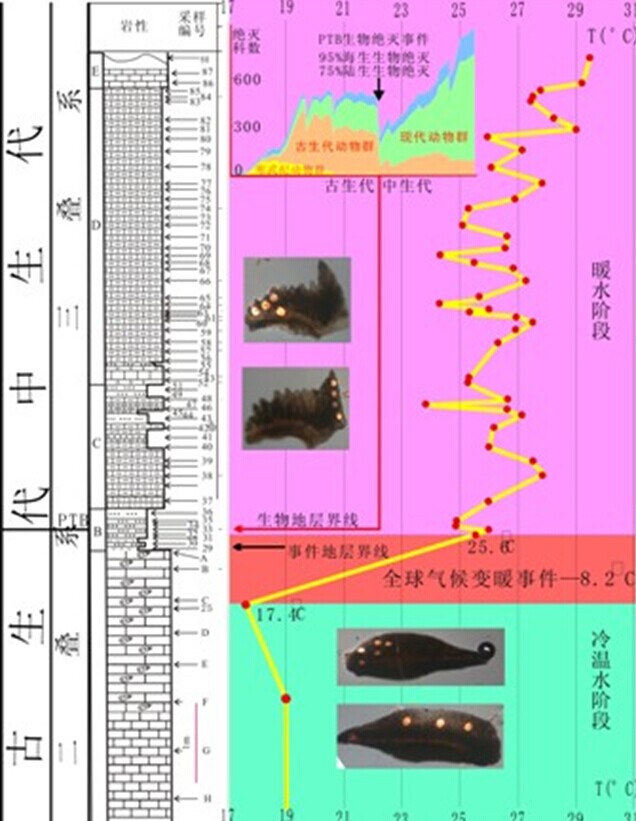
SHRIMP Iie-MC in situ micro analysis of oxygen isotope in conodont suggests global climate change.
6. Paleontological research progress
The paleontology laboratory of institute of geology made progress in the field of Mesozoic and Proterozoic organic evolution research in 2011 and relevant achievements have been published in Nature, Science, Evolution and Development. Sponsored by National Basic Research Program of China (973 Program),geological survey program, and Natural Science Foundation of China, three teams led by Ji Qiang, Lu Junchang, and Tangfeng discovered Middle Jurassic Juramaia sinensis (new genus, new species) and fulfilled fossil record gap of early mammal evolution. Fossil age and DNA research are matched. This represents a new milestone of mammal evolution history with fossils as peg points. A female darwinopterus fossil preserved with an egg acts as evidence to determine gender of extinct flying reptiles, addressing gender identification problem of pterosaur and providing information on reproduction and taphonomy. Ediacaran/Sinian macroscopic fossil of Eoandromeda octobrachiata found in Guizhou, China belongs to ctenophore of primitive community, providing fossil basis to trace early multicellular organisms.

Juramaia sinensis fossil and restored figure
7. Mineral resources management platform of the Institute of Mineral Resources
Supported by special fund and the Ministry of Land and Resources, Researcher Wang Ruijiang, Wang Anjian, Li Houmin of the Institute of Mineral Resources organized systematic survey of 28 types of ores over 21600 properties with joint effort of about 20 thousand people around China, including oil, natural gas, coalbed methane, uranium, potash, bauxite, rare earth, phosphorus, iron, tungsten, antimony, copper, lead, zinc, gold, coal, manganese, chromium, nickel, molybdenum, silver, tin, lithium, pyrite, fluorite, barite, magnesite, and boron. The team summarized 24 provincial minerals over 30 provinces (cities), clarified resources, and built spatial database to confirm resources of properties. The team built grade-tonnage model of 28 ores at various scales, developed coal technical and economic evaluation software, and put forward a new concept of 'recoverable resources' and designed computational formula for various types of properties. The team built reserves management platform of 28 ore types based on 2D half-space graphic database and national resources and reserves dynamic management system, providing important technical support to mineral administration of land and resources.
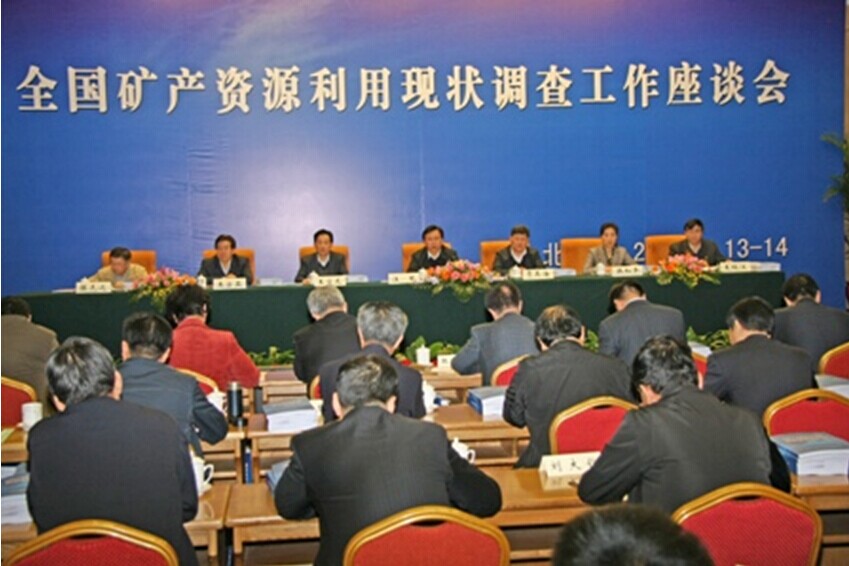
8. A breakthrough made in prospecting of Boziguoer niobium-tantalum deposit in Baicheng County, Sinkiang
Sponsored by Sinkiang Mining Pty Ltd. and Sinkiang 305 Program, from 2007 to 2011, Researcher Zou Tianren and Xu Haiming conducted exploration and evaluation of Boziguoer niobium-tantalum deposit discovered by Zou Tianren et al. in 1998 in Baicheng County, Sinkiang. It is confirmed that the top Boziguoer alkali granite stock is underlain by aegirine pegmatite, aegirine albite granite, riebeckite, and aegirine granite. Niobium-tantalum-rubidium deposit is formed through magmatic crystallization differentiation. Niobium and tantalum are hosted by pyrochlore and rubidium is hosted by astrophyllite, being new type of niobium-tantalum-rubidium deposit. Boziguoer niobium-tantalum deposit is a super-large deposit according to evaluation of Sinkiang reserves evaluation center and approval and filing of Sinkiang national land and resources administration. Processing and metallurgical test suggest that processing results are good and that niobium, tantalum, and rubidium can be extracted through wet hydrometallurgical process. Boziguoer niobium-tantalum deposit has important economic value. This achievement is one of successful examples in prospecting.
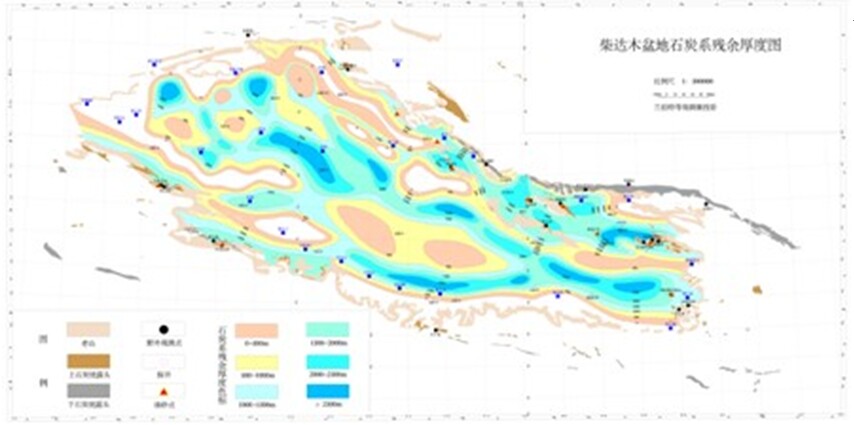
Carboniferous residual thickness map in Qaidam Basin
10. Research achievements of stage establishment of main dated formations in China
Sponsored by geological survey program, Researcher Wang Zejiu, Yao Jianxin, and Huang Zhigao of Chinese Academy of Geological Sciences have been dedicated to research on stage establishment of main dated formations with other domestic experts in the field of formation paleontology. Thus, national candidates of boundary stratotype profiles made breakthrough progress. The team conducted systematic research on 59 stages among 102 stages of Chinese regional chronostratigraphic table. Nine global stratotype section and point (GSSP-Golden Spike) are approved by International Commission on Stratigraphy and International Union of Geological Sciences, making China become a country with the most 'golden spikes'. The research team also conducted in-depth research on 16 stage units and made them meet requirements of stage establishment. Research level of other 2 system units and 33 stage units has been greatly improved. The team has published 121 papers in domestic and international journals and has submitted 60 high-quality research reports. Relevant achievements of this typical research project have greatly improved national stratigraphy research and enhanced its international academic influence.
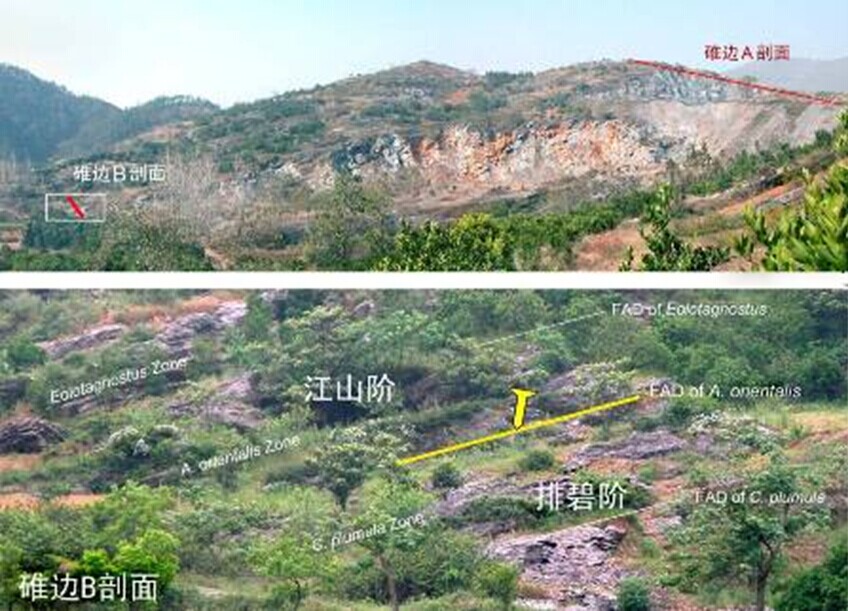
Stratotype section of Jiangshan Stage, Cambrian of Jiangshan, Zhejiang

